Body length: 12–24 mm.
Eyes: eye interommatidial setaeseta:
a sclerotized hair-like projection of the cuticle
absent, eye deeply emarginateemarginate:
notched at the margin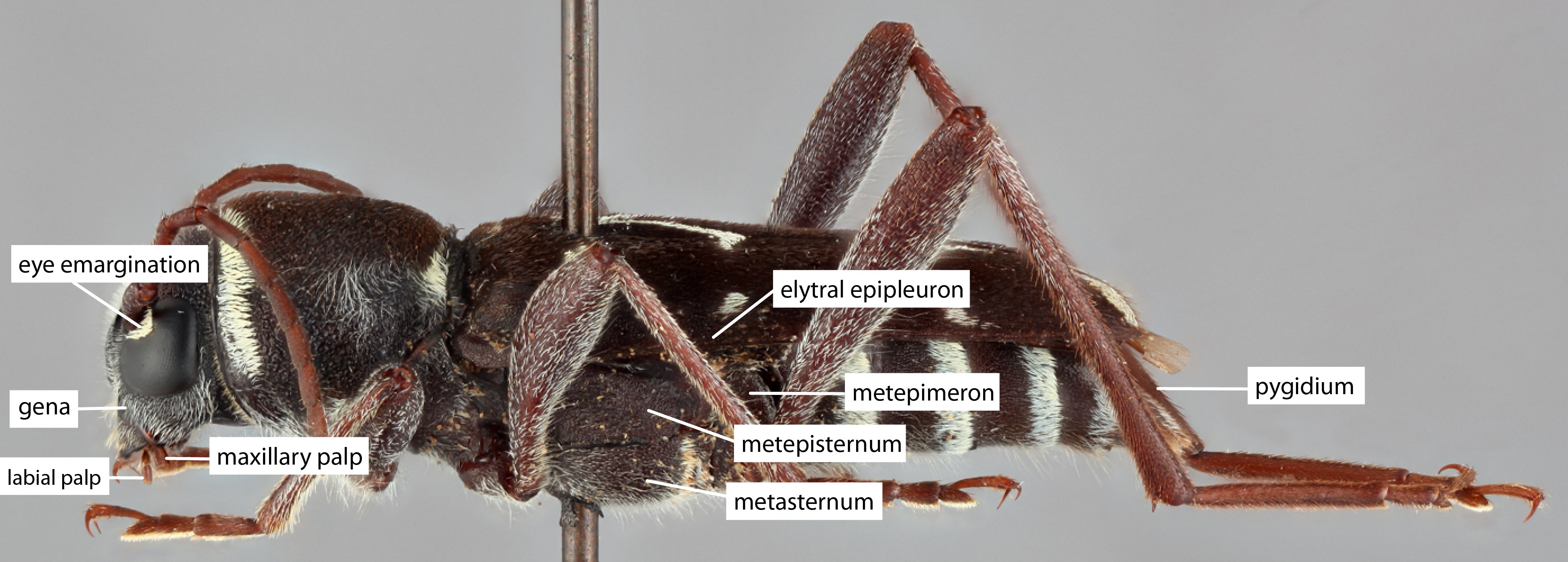 > half width, eye ommatidial density coarse.
> half width, eye ommatidial density coarse.
Antennaeantenna:
in larval and adult insects, paired segmented appendages, borne one on each side of the head, functioning as sense organs and bearing a large number of sensilla
: antennal length reaching/surpassing end of body, antennal flagellar segments elongateelongate:
much longer than wide
, scapescape:
the first proximal segment of the antenna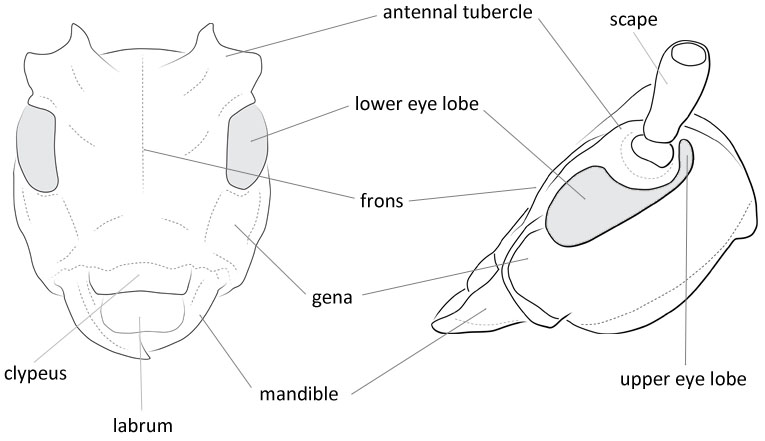 cicatrix (scar) at apexapex:
cicatrix (scar) at apexapex:
end of any structure distad to the base
, antennal scapescape:
the first proximal segment of the antenna ≥ segment 3 or segment 3 > scapescape:
≥ segment 3 or segment 3 > scapescape:
the first proximal segment of the antenna .
.
Pronotumpronotum:
the upper and dorsal part of the prothorax
: pronotumpronotum:
the upper and dorsal part of the prothorax
shape transversetransverse:
broader than long
, pronotumpronotum:
the upper and dorsal part of the prothorax
lateral armature acute spinespine:
a protuberance with an acute (sharp) distal end
.
Prosternum: prosternal processprosternal process:
a posterior extension of the prosternum between the coxae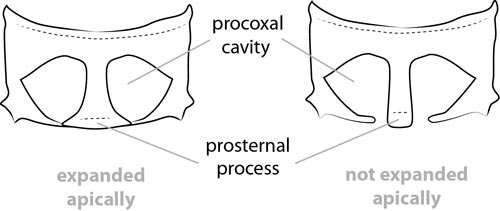 dilated at apexapex:
dilated at apexapex:
end of any structure distad to the base
, procoxal cavities closed posteriorly.
Elytraelytron:
the leathery forewing of beetles, serving as a covering for the hind wings, commonly meeting opposite elytron in a straight line down the middle of the dorsum in repose
: elytral length reaching or close to end of abdomen, elytral apicesapex:
end of any structure distad to the base
with tooth or spinespine:
a protuberance with an acute (sharp) distal end
, elytral color brown or orange, elytral color pattern present or absent.
Legs: visible tarsomerestarsomere:
subdivision or article of the tarsus, usually numbering from two to five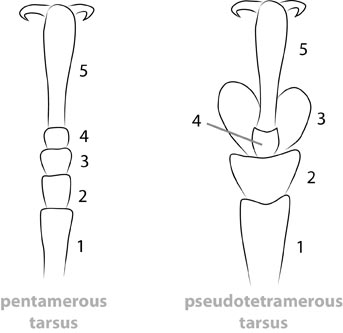 : 4, femora slender, rarely robust, protibial spursprotibial spur:
: 4, femora slender, rarely robust, protibial spursprotibial spur:
sclerotized spine(s) located at the distal tibia; can be single, double, or absent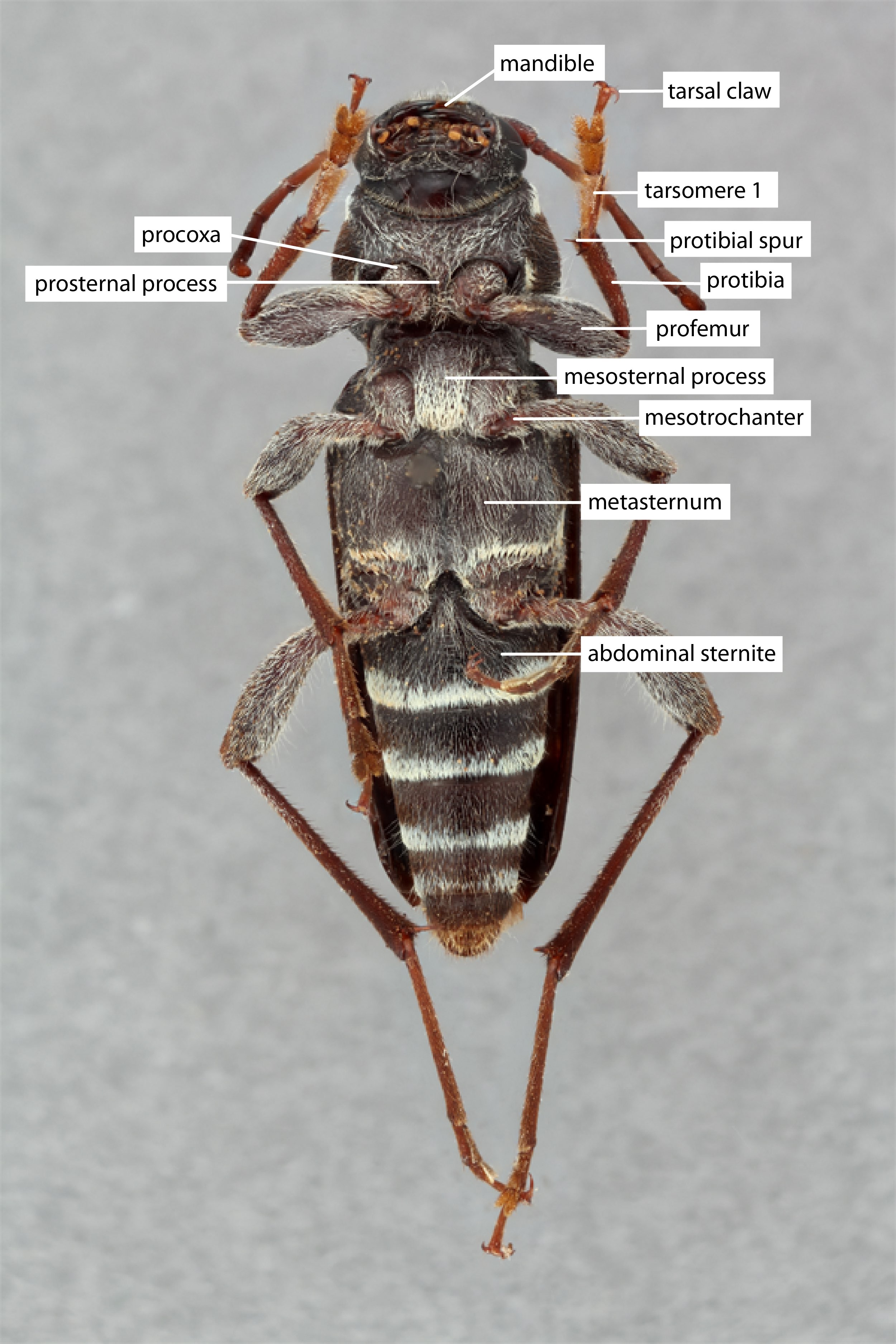 : 2, tarsal clawstarsal claw:
: 2, tarsal clawstarsal claw:
usually paired claws of the pretarsus, at the distal end of the leg simple.
simple.
Elongate. Antennaeantenna:
in larval and adult insects, paired segmented appendages, borne one on each side of the head, functioning as sense organs and bearing a large number of sensilla
fairly strong, twice as long as the male body or a little longer than the female, not fringed below; scapescape:
the first proximal segment of the antenna long, a little strangled before the extremity, sometimes with an open scar, but not very distinct; third article a little longer than the scapescape:
long, a little strangled before the extremity, sometimes with an open scar, but not very distinct; third article a little longer than the scapescape:
the first proximal segment of the antenna , much longer than the fourth. Distant antennal tubers, moderately tall. Eyes rather coarsely faceted, strongly indented, with small lower lobes. Fronsfrons:
, much longer than the fourth. Distant antennal tubers, moderately tall. Eyes rather coarsely faceted, strongly indented, with small lower lobes. Fronsfrons:
the upper anterior portion of the head capsule, usually a distinct sclerite between the epicranium and clypeus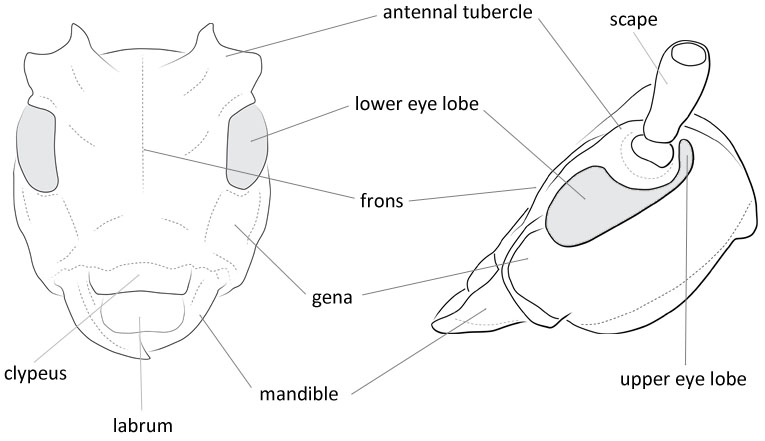 much wider than high. Pronotumpronotum:
much wider than high. Pronotumpronotum:
the upper and dorsal part of the prothorax
transversetransverse:
broader than long
, with four fine transversetransverse:
broader than long
furrows (two anterior and two posterior, the second anterior very sinuoussinuous:
undulating, curved in and out
, the first posterior deep and also very sinuoussinuous:
undulating, curved in and out
), of a long conicalconical:
wider at base than apex
lateral spinespine:
a protuberance with an acute (sharp) distal end
, very pointed, situated in the middle of the edge, and of three obtuse disc bumps (a rather large posterior median, and, on each side, a smaller anterior). Elytraelytron:
the leathery forewing of beetles, serving as a covering for the hind wings, commonly meeting opposite elytron in a straight line down the middle of the dorsum in repose
elongated, with prominent shoulders, very narrow at the apical third, each stretched at the end in a long thin spinespine:
a protuberance with an acute (sharp) distal end
, pointed and divergentdivergent:
spreading out from a common base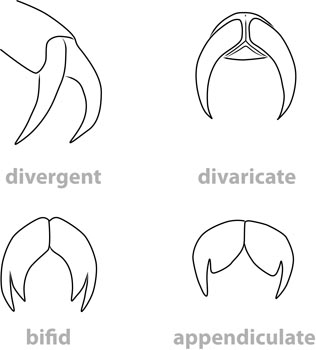 , flattened on the disc, perpendicular laterally, their two parts separated by an obtuse crest, composed of numerous granules, beginning at the humeral callus and extending to the apical spinespine:
, flattened on the disc, perpendicular laterally, their two parts separated by an obtuse crest, composed of numerous granules, beginning at the humeral callus and extending to the apical spinespine:
a protuberance with an acute (sharp) distal end
. In the middle of the basebase:
the part of any appendage or structure that is nearest the body
of each elytronelytron:
the leathery forewing of beetles, serving as a covering for the hind wings, commonly meeting opposite elytron in a straight line down the middle of the dorsum in repose
is a large, smooth, raised granule. Non-retractable head. Narrow prosternal projection, less high than the coxae, regularly arched; mesosternal protrusion rounded forward. Very short metasternum. Atrophied wings. Legs fairly long, thin; linear femurs (adapted from Breuning 1950Breuning 1950:
Breuning S. 1950. Révision des "Morimopsini". In: Lepesme, P. (Ed.), Longicornia. Études et notes sur les longicornes. Volume I. Paul Lechevalier, Paris, pp. 161–262.).
Parechthistatus
The large rounded granule at the basebase:
the part of any appendage or structure that is nearest the body
of each elytronelytron:
the leathery forewing of beetles, serving as a covering for the hind wings, commonly meeting opposite elytron in a straight line down the middle of the dorsum in repose
and elongated spinous elytral apicesapex:
end of any structure distad to the base
will differentiate from other similar genera.
Japan, China
broadleaf; Abies, Picea, Larix, Tsuga; Chamaecyparis
4 species. Conifers: M. fujisanus, M. taniguchii.
Mesechthistatus Breuning, 1950Breuning, 1950:
Breuning S. 1950. Révision des "Morimopsini". In: Lepesme, P. (Ed.), Longicornia. Études et notes sur les longicornes. Volume I. Paul Lechevalier, Paris, pp. 161–262.